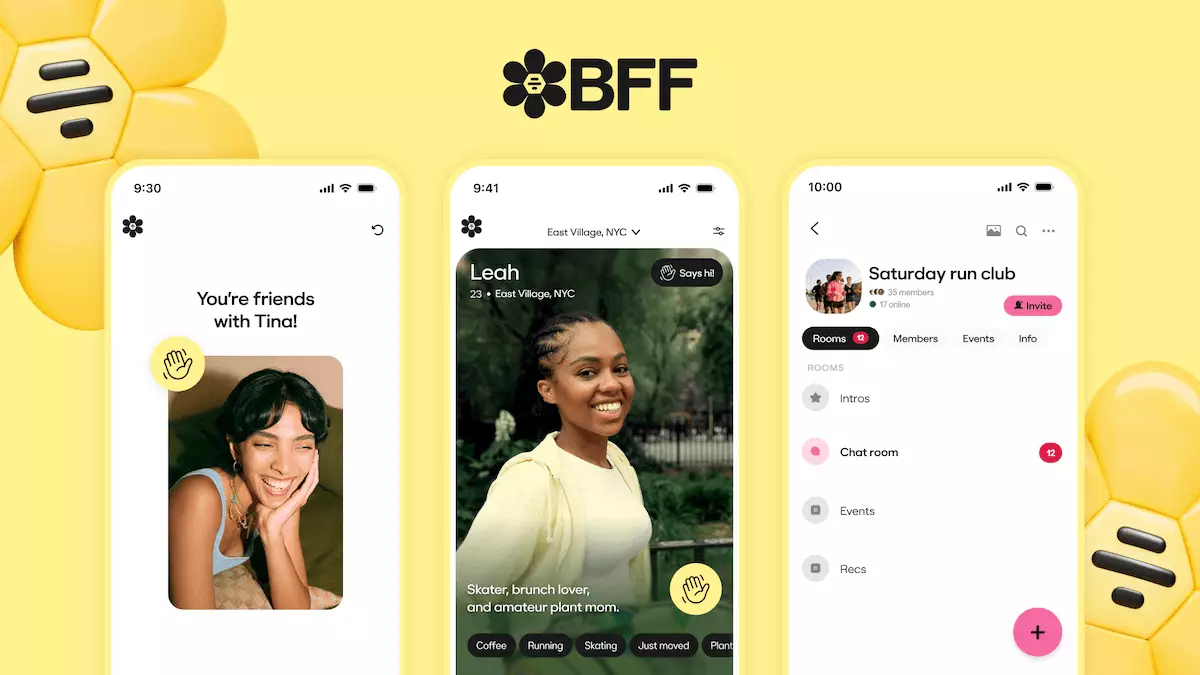In an era where authentic human connections are increasingly sought after amid pervasive digital interactions, Bumble’s strategic relaunch of its BFF app highlights a pivotal shift in how young adults seek to expand their social horizons. The company’s decision to turbocharge its friendship platform reflects a keen understanding of evolving needs—not merely to match profiles but to foster meaningful community engagement. By integrating features that encourage group interactions, Bumble is challenging the conventional one-on-one matching paradigm and positioning itself as a facilitator of genuine social bonds.
Instead of merely serving as a dating or casual chat platform, Bumble BFF’s revamp underscores a nuanced recognition: friendships thrive in community contexts. The deployment of community-centric features like chat rooms, event planning, and grouped conversations hints at a vision where digital platforms act as catalysts for real-world interactions. This approach is more aligned with younger generations’ expectations, who prioritize authenticity, shared interests, and local community-building over superficial swipes or fleeting online encounters.
Additionally, this pivot reveals a broader trend: social apps that facilitate meaningful interactions rather than temporary, surface-level exchanges are becoming indispensable. Bumble’s move exemplifies how tech companies must evolve—merging entertainment with social utility—to retain relevance in a crowded marketplace.
Strategic Acquisition and Its Implications
The transition from Geneva to Bumble BFF is emblematic of a strategic consolidation that reflects both opportunistic foresight and pragmatic adaptation. Geneva, once envisioned as a community-oriented social network, failed to deliver financial returns, prompting Bumble to repurpose its capabilities into a more impactful format. This decision underscores a critical insight for digital entrepreneurs: innovation often involves redefining existing assets to better serve user needs and market trends.
Bumble’s willingness to phase out Geneva and upgrade existing users seamlessly is a savvy move—preserving loyalty while redirecting resources toward a more promising venture. It also signals the company’s agility in navigating financial pressures, especially given its recent revenue dip of 7.6% in Q2 2025. Maximize the value of user bases by integrating them into a fresh ecosystem that emphasizes community and engagement, rather than abandoning effort altogether, exemplifies strategic resilience.
Furthermore, Bumble’s focus on creating a unified platform for both romantic and platonic connections could signal an integrated approach to social networking. By seamlessly blending dating, friendships, and community involvement, Bumble aims to foster comprehensive social ecosystems, encouraging users to spend more time within its app, nurturing relationships of all kinds.
Responding to Competitive and Cultural Shifts
The timing of Bumble’s relaunch coincides with a notable influx of apps dedicated to fostering genuine friendships—such as Clockout, Clyx, and Les Amís. In a landscape flooded with niche platforms, Bumble’s efforts to enhance its BFF features appear as a calculated move to stay competitive by emphasizing community-oriented engagement rather than solely matching algorithms.
More significantly, this strategic shift taps into broader cultural currents: young adults increasingly reject superficial online interactions in favor of authentic community building. With nearly half of young users actively craving more friends and local engagement, Bumble’s emphasis on community, events, and group chats reflects a deep understanding of these social aspirations. The company is positioning itself as a purveyor of not just fleeting moments but enduring connections rooted in shared interests and physical proximity.
Yet, skepticism remains warranted. Despite the optimistic outlook, the app’s discovery function remains delayed until February 2026, which could hinder quick adoption. The challenge lies in transforming the initial engagement—through groups, events, and chats—into sustained, meaningful friendships that users find genuinely valuable. Only time will tell if Bumble’s reimagined platform can truly meet these expectations at scale.
Balancing Innovation with Caution
Bumble’s bold reimagining of its BFF app embodies a proactive effort to redefine social interaction in a digital context. However, with revenue declining and significant investments fueling these new features, the company faces the delicate task of balancing innovation with financial stability. Success hinges on whether users find value in the community-focused features and whether these can translate into a loyal user base that stays engaged beyond superficial interactions.
At its core, Bumble’s initiative reflects a core truth: in a world dominated by digital connectivity, the most enduring human experiences happen face-to-face, often facilitated by online platforms. Bumble’s attempt to bridge this gap—by fostering communities and real-world connections—could serve as an influential blueprint not just for social apps but for all digital platforms claiming to enhance human relationships.
While some may criticize the delay in unveiling the discovery aspect or question the platform’s ability to succeed amid fierce competition, Bumble’s willingness to innovate reflects a broader optimism: that amid challenges, genuine friendship and community remain essential human pursuits worth investing in—especially with a platform daring enough to put these values at its core.

